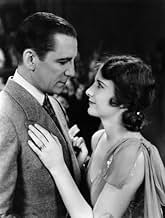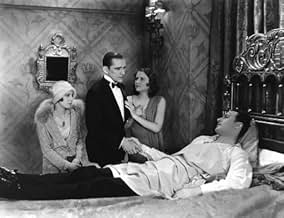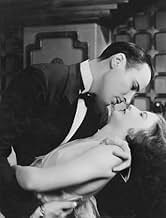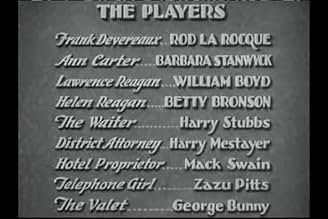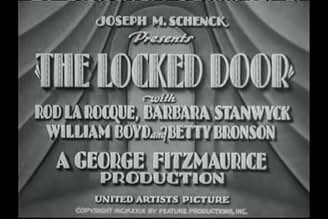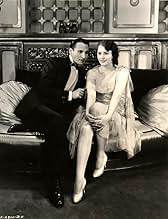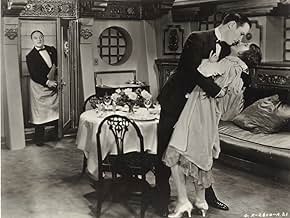अपनी भाषा में प्लॉट जोड़ेंOn her first anniversary, Ann Reagan finds that her sister-in-law is involved with a shady character from her own past, and determines to intervene.On her first anniversary, Ann Reagan finds that her sister-in-law is involved with a shady character from her own past, and determines to intervene.On her first anniversary, Ann Reagan finds that her sister-in-law is involved with a shady character from her own past, and determines to intervene.
Zasu Pitts
- Telephone Girl
- (as Zazu Pitts)
Mary Ashcraft
- Girl on Rum Boat
- (बिना क्रेडिट के)
Violet Bird
- Girl on Rum Boat
- (बिना क्रेडिट के)
Earle Browne
- Bit Part
- (बिना क्रेडिट के)
Clarence Burton
- Police Officer
- (बिना क्रेडिट के)
Lita Chevret
- Girl on Rum Boat
- (बिना क्रेडिट के)
Gilbert Clayton
- Bit Part
- (बिना क्रेडिट के)
Pauline Curley
- Bit Part
- (बिना क्रेडिट के)
Edgar Dearing
- Cop
- (बिना क्रेडिट के)
Edward Dillon
- Bit Part
- (बिना क्रेडिट के)
फ़ीचर्ड समीक्षाएं
George Fitzmaurice was one of the great commercial stylists among directors in the 1920s. He suffered an eclipse in the early talkie era but was fighting his way back into the majors when he died in 1940.
This means, of course, there are a lot of problems with this movie. The screen actors don't know how to do dialogue and most of the stage actors don't know how to turn down their performances for the intimacy of the movie camera. Barbara Stanwyck, looking very fresh-faced, is very loud in her line readings. She knows how to show her emotions beautifully already, though.
But producer Joe Schenck didn't spare any expense behind the camera, and it shows. Avant-garde cameraman Ray June handles the camera impeccably. While other directors were having their cameramen use cuts to change subjects, Fitzmaurice has June move the camera. Notice the long tracking shot at the bar in the opening sequence and the MOS shots used to fill out the sequence.
The camera-work is not fluid. It is, frankly, fairly clunky, but it is light years ahead of anyone else in the business in 1929, except possibly Mamoulian's APPLAUSE.
So while their are a lot of problems with this movie, the camera-work makes this one very superior for 1929 and Barbara Stanwyck makes it worth looking at.
This means, of course, there are a lot of problems with this movie. The screen actors don't know how to do dialogue and most of the stage actors don't know how to turn down their performances for the intimacy of the movie camera. Barbara Stanwyck, looking very fresh-faced, is very loud in her line readings. She knows how to show her emotions beautifully already, though.
But producer Joe Schenck didn't spare any expense behind the camera, and it shows. Avant-garde cameraman Ray June handles the camera impeccably. While other directors were having their cameramen use cuts to change subjects, Fitzmaurice has June move the camera. Notice the long tracking shot at the bar in the opening sequence and the MOS shots used to fill out the sequence.
The camera-work is not fluid. It is, frankly, fairly clunky, but it is light years ahead of anyone else in the business in 1929, except possibly Mamoulian's APPLAUSE.
So while their are a lot of problems with this movie, the camera-work makes this one very superior for 1929 and Barbara Stanwyck makes it worth looking at.
Someone referred to this as "stagy," and was more correct than perhaps he knew: "The Locked Door" was originally a stage play, and this movie was an adaptation, a good one in my opinion.
C. Gardner Sullivan had been writing scenarios and inter-titles since at least 1912, and is honored among aficionados who know his work from those earliest years of motion pictures.
The four top-billed players were also veterans, except for Barbara Stanwyck who has only one previous credit.
Rod La Rocque had been in movies since at least 1914, and put in 12 more years.
Betty Bronson became a huge star with her seventh role, Peter Pan in the movie of that name, and reportedly was chosen for the part by James M. Barrie, the author, himself.
William Boyd, known here at IMDb as "William 'Stage' Boyd," is the primary reason the Screen Actors Guild usually forbids a member having the same name as another, Harrison Ford being the only exception that comes immediately to my mind.
This particular Boyd was busted on something shameful and the picture of "the other" William Boyd, who later became very famous as Hopalong Cassidy, was published in a newspaper, almost destroying his career.
In this cast there are lots of "withs" who help make this a very good movie, including Mack Swain and Zasu Pitts.
The story is not really a mystery, at least not to us, because we see everything that happens, but it is a drama, with conflict and character change.
I'm reminded of the aphorism that people in small towns buy their local paper not to see who did what, because everyone knows, but to see who gets blamed.
That's the premise of this story, and it's well done, plausible by the standards of its time.
There is also a good point for modern society: Laws against consensual acts, such as gambling or ingestion of certain substances, in this case, alcohol, cause more problems than they solve.
"The Locked Door" is good cinema, especially for anyone who wants to watch the evolution of the art.
C. Gardner Sullivan had been writing scenarios and inter-titles since at least 1912, and is honored among aficionados who know his work from those earliest years of motion pictures.
The four top-billed players were also veterans, except for Barbara Stanwyck who has only one previous credit.
Rod La Rocque had been in movies since at least 1914, and put in 12 more years.
Betty Bronson became a huge star with her seventh role, Peter Pan in the movie of that name, and reportedly was chosen for the part by James M. Barrie, the author, himself.
William Boyd, known here at IMDb as "William 'Stage' Boyd," is the primary reason the Screen Actors Guild usually forbids a member having the same name as another, Harrison Ford being the only exception that comes immediately to my mind.
This particular Boyd was busted on something shameful and the picture of "the other" William Boyd, who later became very famous as Hopalong Cassidy, was published in a newspaper, almost destroying his career.
In this cast there are lots of "withs" who help make this a very good movie, including Mack Swain and Zasu Pitts.
The story is not really a mystery, at least not to us, because we see everything that happens, but it is a drama, with conflict and character change.
I'm reminded of the aphorism that people in small towns buy their local paper not to see who did what, because everyone knows, but to see who gets blamed.
That's the premise of this story, and it's well done, plausible by the standards of its time.
There is also a good point for modern society: Laws against consensual acts, such as gambling or ingestion of certain substances, in this case, alcohol, cause more problems than they solve.
"The Locked Door" is good cinema, especially for anyone who wants to watch the evolution of the art.
Handsome but oily playboy Rod La Rocque (as Frank Devereaux) takes secretary Barbara Stanwyck (as Ann Carter) on a Prohibition-era cruise aboard a boozy gambling boat. He locks their cabin door for dinner and sex, but a police raid saves Ms. Stanwyck from date rape. Eighteen months later, Stanwyck has happily married well-heeled William Boyd (as Lawrence "Larry" Reagan). Then, Stanwyck is shocked to discover Mr. La Rocque is charming cute sister-in-law Betty Bronson (Helen). Stanwyck wants La Rocque to hit the road without Ms. Bronson, so he threatens to reveal her participation on the opening cruise.
Director George Fitzmaurice does his best maneuvering everyone around the early sound-equipped stages.
Viewers in 1929 likely remembered the original "The Sign on the Door" (1921) starring Norma Talmadge and Lew Cody in the Stanwyck and La Rocque roles; this film survives, but has not been released. La Rocque, a popular cad, and perky "Peter Pan" star Bronson were likely the main draws in this "All Talking!" re-make. Now, it's seen as the first big role for Stanwyck. Unafraid to repeatedly show her underwear, Stanwyck is bold but inexperienced. Bronson measures theatrical. La Rocque is at his smarmy best, and Mr. Boyd lends good support. Telephone operator Zasu Pitts and dumb waiter Harry Stubbs provide comic relief.
***** The Locked Door (11/16/29) George Fitzmaurice ~ Barbara Stanwyck, Rod La Rocque, William 'Stage' Boyd, Betty Bronson
Director George Fitzmaurice does his best maneuvering everyone around the early sound-equipped stages.
Viewers in 1929 likely remembered the original "The Sign on the Door" (1921) starring Norma Talmadge and Lew Cody in the Stanwyck and La Rocque roles; this film survives, but has not been released. La Rocque, a popular cad, and perky "Peter Pan" star Bronson were likely the main draws in this "All Talking!" re-make. Now, it's seen as the first big role for Stanwyck. Unafraid to repeatedly show her underwear, Stanwyck is bold but inexperienced. Bronson measures theatrical. La Rocque is at his smarmy best, and Mr. Boyd lends good support. Telephone operator Zasu Pitts and dumb waiter Harry Stubbs provide comic relief.
***** The Locked Door (11/16/29) George Fitzmaurice ~ Barbara Stanwyck, Rod La Rocque, William 'Stage' Boyd, Betty Bronson
Stagy but clever murder mystery with Barbara Stanwyck in her talkie debut and the center of attention.
The copy I have has a missing scene but this is still an effective if stagy and slightly hammy film.
Stanwyck is a secretary who goes to a boat party with the boss's son and maybe gets raped (that scene is missing) and raided by the police. She and the son skip bail and disappear. 18 months later we find Stanwyck happily married to a wealthy man (William Boyd) when his sister's new boy friend shows up. Yup it's the sleazy son (Rod LaRocque) with a new name. The sister (Betty Bronson) is gaga over him but Stanwyck is horrified.
Stanwyck overhears their plans to run off to Honolulu so she decides to pay LaRocque a visit. But unbeknown to her, her husband is also planning a visit because he has been warned about the boy friend.
Stanwyck arrives at LaRocque's apartment and starts a fight but is interrupted when the husband arrives. The guys scuffle and a gun goes off. Husband leaves and locks the door, trapping Stanwyck (hiding in a bedroom) in the apartment with the corpse. She thinks fast, rips her dress and calls the operator, pretending to fend off an attacker and firing the gun.
Both Stanwyck and Boyd eventually admit to the killing but then Bronson shows up.....
Supporting cast includes Zasu Pitts as the operator, Mack Swain as the manager, George Bunny as the valet, Purnell Pratt is a police man, and Harry Stubbs is the surprising waiter.
Neat little film apparently lost for decades.
The copy I have has a missing scene but this is still an effective if stagy and slightly hammy film.
Stanwyck is a secretary who goes to a boat party with the boss's son and maybe gets raped (that scene is missing) and raided by the police. She and the son skip bail and disappear. 18 months later we find Stanwyck happily married to a wealthy man (William Boyd) when his sister's new boy friend shows up. Yup it's the sleazy son (Rod LaRocque) with a new name. The sister (Betty Bronson) is gaga over him but Stanwyck is horrified.
Stanwyck overhears their plans to run off to Honolulu so she decides to pay LaRocque a visit. But unbeknown to her, her husband is also planning a visit because he has been warned about the boy friend.
Stanwyck arrives at LaRocque's apartment and starts a fight but is interrupted when the husband arrives. The guys scuffle and a gun goes off. Husband leaves and locks the door, trapping Stanwyck (hiding in a bedroom) in the apartment with the corpse. She thinks fast, rips her dress and calls the operator, pretending to fend off an attacker and firing the gun.
Both Stanwyck and Boyd eventually admit to the killing but then Bronson shows up.....
Supporting cast includes Zasu Pitts as the operator, Mack Swain as the manager, George Bunny as the valet, Purnell Pratt is a police man, and Harry Stubbs is the surprising waiter.
Neat little film apparently lost for decades.
The attraction here is not just Barbara Stanwyck, even though it's her first talkie and she handles her role with a secure professionalism that belies her cinematic inexperience. Born for the camera she was! But an equally impressive performance is delivered by Rod La Rocque as the serial cad who mistreats her and then sets his sights on her younger sister. The trappings are typical 20's soap opera/melodrama, in this case derived from a stage play. But not typical for the era is La Rocque's well-tailored villain who seems to have stepped out of a story from a much later era; in fact, his performance would not be considered one bit dated even by today's standards - highly unusual for a film from 1929. His line readings and body language bespeak a decadent, spoiled rogue without a scintilla of conscience, all of this enhanced by delicately tapered sideburns. He also has a smooth, deep speaking voice. The look and style of the film are standard for the era but include an interesting, lively panoramic dance party sequence on a "drinking boat" (pleasure boats that sailed outside the 12-mile limit of the US coast so the patrons could drink alcohol illegally during the Prohibition era) intercut with an intimate scene between Stanwyck and La Rocque in one of the cabins.
क्या आपको पता है
- ट्रिवियाOther than one bit part, this is Barbara Stanwyck's feature film debut.
- भाव
Frank Devereaux: Shoot yourself in the head, and if you live, you can become a Waiter.
- कनेक्शनFeatured in Visions of Light (1992)
- साउंडट्रैकI've Got a Feeling I'm Falling
(uncredited)
Written by Fats Waller and Harry Link
First tune played on the boat
टॉप पसंद
रेटिंग देने के लिए साइन-इन करें और वैयक्तिकृत सुझावों के लिए वॉचलिस्ट करें
- How long is The Locked Door?Alexa द्वारा संचालित
विवरण
- चलने की अवधि
- 1 घं 14 मि(74 min)
- रंग
- पक्ष अनुपात
- 1.20 : 1
इस पेज में योगदान दें
किसी बदलाव का सुझाव दें या अनुपलब्ध कॉन्टेंट जोड़ें

